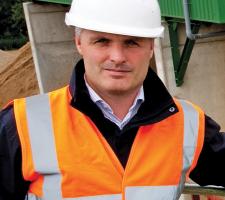
As the EU calls for recycling of CD&E waste across Europe to reach 70% by 2020 has Brussels got the criteria right, or should we be looking at quality and not quantity? Peter Craven, head of marketing and sales support at
In the UK, over 90 million tonnes of CD&E (construction, demolition and excavation waste) is generated each year. In Europe the figure from construction, demolition and civil engineering projects is in excess of 1,000 million tonnes representing a huge sustainable resource that is not being utilised to its full potential.
In the UK 20% of the total aggregates used in construction comes from a recycled source which equates to approximately 40% of the total CD&E waste generated being recycled into products for the building industry.
Under the revised Waste Framework Directive (rWFD) Brussels is calling for all EU Member States to recover a minimum 70% of the waste generated from CD&E material by 2020. In 2013 the first reporting is expected where progress will be measured, with further key performance indicators (KPIs) being every three years up to and including 2020.
While the overall feeling is that the UK is on track to meet these targets, being in the Top 10 of countries in the European recycling league table, a document from Defra (Department for Environment, Food and Rural Affairs) entitled Methodology for Estimating Annual Waste Generation from the Construction, Demolition and Excavation (CD&E) Sectors in England, written by the Waste Statistics Team, proclaims that due to the combined pressures to meet these targets there is an urgent need to better understand the waste generation and management activities of the CD&E sectors in the UK.
The last survey of the volumes recycled in the CD&E waste sector was commissioned by WRAP (Waste & Resource Action Programme) in the UK in 2008 with results published in 2010. With 2013 being a pivotal date for measuring progress we must assume that the data that the market is currently working from is out of date.
Regardless of the current position, to increase volumes of the material being recycled there are a number of criteria that will significantly enable and enhance the chances of the UK meeting the 2020 targets. Planners need to understand how advances in technology for the recycling of CD&E waste has improved in recent years and how recycled material is now being seen as a high value product.
Permissions for increased processing of waste through existing plants would be key with quicker planning decisions for the construction of new plants to increase volume. In addition it is vital that the public perception of recycled CD&E waste is improved by raising awareness that recycled material is a quality product deserving a higher position in the value chain.
Communicating that materials recycled from CD&E waste are capable of being processed into higher grade materials and products would certainly create an increase in demand, thus increasing the volumes being recycled.
Doubters may say that quantity should be the criteria by which success is judged, not quality. However the construction industry in Belgium achieved more than 90% in its recycling of CD&E waste material, before pushing the boundaries yet again focusing on not just quantity but on improving the overall quality of the product it produced.
These are the types of initiative which the UK could leverage to meet the targets set out by the EU.
The technology with which to process CD&E materials has advanced at a rapid pace and it is now possible to refine more materials into higher quality product while improving the overall percentage of material processed.
In many cases in excess of 95% of CD&E waste can be reused. What is not changing at the same pace is the attitude of the industry. The planners, architects, specifiers and contractors as well as the local authorities do need to be aware that the standard that can be achieved is of the highest quality: the sooner this is a more meaningful recycling agenda should be agreed upon.
If the UK and the rest of the EU Member States are to be measured by quantity alone, this could be seen as just a box-ticking exercise to keep Brussels happy. While the initial value in this overall process is volume and diverting material from landfill, the real value should be the ability to create materials of the highest grade that has a multitude of uses, not just as low grade fill material.
Creating a viable alternative to virgin aggregates is not designed to be a means of replacing that material but a way of complementing and protecting what is ultimately a non-sustainable resource.









